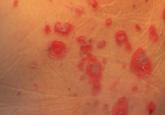Article
Poromatosis in Pregnancy: A Case of 8 Eruptive Poromas in the Third Trimester
The poroid family of neoplasms includes hidroacanthoma simplex, eccrine poroma, dermal duct tumor, and poroid hidradenoma. These benign adnexal...
Alma Leyla Dehdashti, DO; Schield M. Wikas, DO
Dr. Dehdashti is from Mid-Michigan Dermatology, PLLC, Lansing. Dr. Wikas is from Tri-County Dermatology, Inc, Cuyahoga Falls, Ohio.
The authors report no conflict of interest.
Correspondence: Alma Leyla Dehdashti, DO, Mid-Michigan Dermatology, PLLC, Office Park West, 416 S Creyts Rd, Lansing, MI 48917 (almaleyla@gmail.com).

Pruritic urticarial papules and plaques of pregnancy (PUPPP)(also known as polymorphic eruption of pregnancy in Europe) is an intensely pruritic eruption that affects women during the third trimester of pregnancy. Treatment usually is aimed at symptom relief until delivery, as the eruption usually resolves rapidly in the postpartum period. We report the case of a 30-year-old woman who presented 2 weeks postpartum with an intensely pruritic generalized eruption. The eruption started on the abdominal striae within 24 hours of delivery and gradually spread to the buttocks, legs, and arms. Punch biopsy confirmed a diagnosis of PUPPP. Pruritic urticarial papules and plaques of pregnancy presenting in the postpartum period is extremely rare. We present this case for clinical interest and to remind clinicians to keep PUPPP as a consideration in the differential diagnosis when evaluating pruritic eruptions in women who are in the postpartum period.
Practice Points
The cutaneous effects of pregnancy are variable and numerous. We all have likely seen the pigmentary changes induced by pregnancy as well as both exacerbation and complete resolution of preexisting skin conditions. The dermatoses of pregnancy are classified as a group of inflammatory skin conditions exclusively seen in pregnant women, the most common being pruritic urticarial papules and plaques of pregnancy (PUPPP).1 Also known as polymorphic eruption of pregnancy in Europe, PUPPP was first recognized in 1979 as a distinct entity that manifested as an intense pruritic eruption unique to women in the third trimester of pregnancy.2 The condition usually is self-limited, with the majority of cases spontaneously resolving within 4 to 6 weeks after delivery.3,4 Presentation of PUPPP in the postpartum period is rare.1-4 We report a biopsy-proven case of PUPPP in a 30-year-old woman who presented 2 weeks postpartum with an intensely pruritic generalized eruption. A PubMed search of articles indexed for MEDLINE using the search terms pruritic urticarial papules and plaques of pregnancy or polymorphic eruption of pregnancy and postpartum revealed only 5 reports of PUPPP or polymorphic eruption of pregnancy occurring in the postpartum period, 2 occurring in the United States.5-9
Case Report
A 30-year-old woman who was 2 weeks postpartum presented to our dermatology clinic with an intensely pruritic generalized rash. Within 24 hours of delivery of her first child, the patient developed an itchy rash on the abdomen and was started on oral corticosteroids and antihistamines in the hospital. On discharge, she was instructed to follow up with the dermatology department if the rash did not resolve. After leaving the hospital, she reported that the eruption had progressively spread to the buttocks, legs, and arms, and the itching seemed to be worse despite finishing the course of oral corticosteroids and antihistamines.
The patient’s prenatal course was uneventful. She gained 16 kg during pregnancy, with a prepregnancy weight of 50 kg. A healthy male neonate was delivered at 38 weeks’ gestation without complication. The patient’s medical history was unremarkable. Her current medications included prenatal vitamins, oral prednisone, and loratadine, and she reported no known drug allergies.
On physical examination, the patient was afebrile and her blood pressure was normal. Examination of the skin revealed erythematous papules and urticarial plaques involving the abdominal striae with periumbilical sparing (Figure 1A). Similar lesions were noted on the legs, buttocks, and arms (Figure 1B). The face, palms, and soles were uninvolved. No vesicles or pustules were noted. The oral mucosa was pink, moist, and unremarkable.
|
Based on the patient’s clinical presentation, the differential diagnosis included pemphigoid gestationis, a hypersensitivity reaction, cutaneous lupus, cholestasis of pregnancy, and PUPPP. Pruritic urticarial papules and plaques of pregnancy was considered to be unlikely because of the uncharacteristic postpartum presentation of the eruption.
Two 4-mm punch biopsies were performed on the left upper arm and were sent for histopathologic examination and direct immunofluorescence. Laboratory studies including complete blood cell count with differential, complete metabolic panel, antinuclear antibodies, and IgE levels were conducted. The patient was started on triamcinolone cream 0.1% twice daily and her antihistamine was switched from loratadine to cetirizine.
Histopathologic examination revealed a mixed perivascular infiltrate in the superficial dermis consisting of lymphocytes, mast cells, and eosinophils (Figures 2 and 3), which was consistent with a diagnosis of PUPPP. Direct immunofluorescence was negative. Laboratory studies were within reference range and antinuclear antibodies and IgE levels were negative. A diagnosis of postpartum PUPPP was made. Complete resolution of the eruption was experienced by 2-week follow-up (Figures 4A and 4B). The patient noted that her symptoms improved within 2 days of starting topical therapy.
|
Figure 2. Perivascular infiltrate in the superficial dermis (H&E, original magnification ×20). Figure 3. Mixed perivascular infiltrate (H&E, original magnification ×40). |
Comment
Pruritic urticarial papules and plaques of pregnancy complicates 1 of 160 to 1 of 300 pregnancies.1 As seen in our case, the majority of cases of PUPPP are diagnosed in women who are nulliparous or primigravida.10 A study by Aronson et al10 reported that of 57 cases of PUPPP, 24 (42%) patients were primigravida, 16 (28%) were gravida 2, 9 (16%) were gravida 3, 4 (7%) were gravida 4, 3 (5%) were gravida 6, and 1 (2%) was gravida 7. Thirty-nine (68%) patients were nulliparous.10 The average onset of symptoms is approximately 35 weeks’ gestation.9
The poroid family of neoplasms includes hidroacanthoma simplex, eccrine poroma, dermal duct tumor, and poroid hidradenoma. These benign adnexal...

We report the case of a 34-year-old woman who was diagnosed with pemphigus vulgaris (PV) during pregnancy. The patient presented with widespread...
